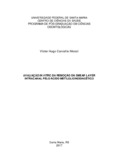| dc.creator | Morari, Víctor Hugo Carvalho | |
| dc.date.accessioned | 2018-07-12T18:03:35Z | |
| dc.date.available | 2018-07-12T18:03:35Z | |
| dc.date.issued | 2017-07-28 | |
| dc.identifier.uri | http://repositorio.ufsm.br/handle/1/13765 | |
| dc.description.abstract | The objective of this study was to evaluate the efficacy of 20% methylglycinediaacetic acid solution in the removal of the intracanal smear layer, using a scanning electron microscope (SEM), longitudinally and quantitatively. The chemical-mechanical preparation of the root canals of human upper central incisors was performed with the ProTaper system up to the instrument F5 and 2,5% NaOCl as an irrigating solution. The teeth were then cleaved and the dentin surface analyzed in the SEM under low vacuum. Images were obtained with 1000x magnifications of the cervical, middle and apical thirds of areas previously determined and completely covered by smear layer. The teeth were reassembled and divided into two groups that received the different solutions for final cleaning of the root canal for 3 minutes: G1 - MGDA and G2 - EDTA. After the final irrigation, the tooth halves were again separated and prepared for analysis of the dentin surface in the SEM in high vacuum. Images with the same magnifications were obtained from the same areas previously evaluated and, through Image J software, the percentage of the area of the open dentinal tubules was calculated in relation to the total area ofthe image. Test t was used for comparison between groups and ANOVA between the thirds of the root canal. The level of significance was 5%. Data presented normal distribution (Shapiro-Wilk test). There was no statistically significant difference in the efficacy of the root smear layer removal between the solutions and nor of their action between the thirds. It is concluded that MGDA solution may be an alternative to the use of EDTA in Endodontics and its properties should be investigated. | eng |
| dc.language | por | por |
| dc.publisher | Universidade Federal de Santa Maria | por |
| dc.rights | Attribution-NonCommercial-NoDerivatives 4.0 International | * |
| dc.rights.uri | http://creativecommons.org/licenses/by-nc-nd/4.0/ | * |
| dc.subject | EDTA | por |
| dc.subject | Microscopia eletrônica de varredura | por |
| dc.subject | Lama dentinária | por |
| dc.subject | Irrigantes do canal radicular | por |
| dc.subject | EDTA | eng |
| dc.subject | Scanning electron microscopy | eng |
| dc.subject | Smear layer | eng |
| dc.subject | Root canal irrigants | eng |
| dc.title | Avaliação in vitro da remoção da smear laer intracanal pelo ácido metilglicinodiacético | por |
| dc.title.alternative | In vitro evaluation of methylglycinediacetic acid on intracanal smear layer removal | eng |
| dc.type | Tese | por |
| dc.description.resumo | O objetivo deste estudo foi avaliar, longitudinal e quantitativamente, por Microscopia Eletrônica de Varredura (MEV), a eficácia da solução de ácido metilglicinodiacético a 20% (MGDA) na remoção da smear layer intracanal. O preparo químico-mecânico dos canais radiculares de incisivos centrais superiores humanos foi realizado com o sistema ProTaper até o instrumento F5 e NaOCl a 2,5% como solução irrigadora. Em seguida, os dentes foram clivados e a superfície dentinária analisada em MEV em baixo vácuo. Foram obtidas imagens com aumentos de 1000x dos terços cervical, médio e apical de áreas previamente determinadas e totalmente recobertas por smear layer. Os dentes foram remontados e divididos em dois grupos que receberam as diferentes soluções para limpeza final do conduto radicular por 3 minutos: G1 – MGDA e G2 – EDTA a 17%. Depois da irrigação final, as metades dos dentes foram novamente separadas e preparadas para análise da superfície dentinária em MEV em alto vácuo. Obteve-se imagens com os mesmos aumentos das mesmas áreas anteriormente avaliadas e, por meio do software Image J, foi calculada a porcentagem da área dos túbulos dentinários abertos em relação à área total da imagem. Test t foi utilizado para comparação entre grupos e ANOVA entre os terços do canal radicular. O nível de significância foi de 5%. Os dados apresentaram distribuição normal (teste Shapiro-Wilk). Não houve diferença estatisticamente significante na eficácia da remoção smear layer radicular entre as soluções e nem da ação destas entre os terços. Conclui-se que solução de MGDA pode ser uma alternativa ao uso do EDTA em Endodontia e suas propriedades devem ser pesquisadas. | por |
| dc.contributor.advisor1 | Schmitz, Marcia da Silva | |
| dc.contributor.advisor1Lattes | http://lattes.cnpq.br/4239733753424639 | por |
| dc.contributor.advisor-co1 | Dullius, Angela Isabel dos Santos | |
| dc.contributor.advisor-co1Lattes | http://lattes.cnpq.br/9045765842523860 | por |
| dc.contributor.referee1 | Grecca, Fabiana Soares | |
| dc.contributor.referee1Lattes | http://lattes.cnpq.br/1571244923940078 | por |
| dc.contributor.referee2 | Dotto, Ronise Ferreira | |
| dc.contributor.referee2Lattes | http://lattes.cnpq.br/2163810633188295 | por |
| dc.contributor.referee3 | Montagner, Francisco | |
| dc.contributor.referee3Lattes | http://lattes.cnpq.br/2937031469516770 | por |
| dc.contributor.referee4 | Dotto, Sidney Ricardo | |
| dc.contributor.referee4Lattes | http://lattes.cnpq.br/6534214233447363 | por |
| dc.creator.Lattes | http://lattes.cnpq.br/7319922923291102 | por |
| dc.publisher.country | Brasil | por |
| dc.publisher.department | Odontologia | por |
| dc.publisher.initials | UFSM | por |
| dc.publisher.program | Programa de Pós-Graduação em Ciências Odontológicas | por |
| dc.subject.cnpq | CNPQ::CIENCIAS DA SAUDE::ODONTOLOGIA | por |
| dc.publisher.unidade | Centro de Ciências da Saúde | por |



